
Sorbus is a genus of over 100 species of trees and shrubs in the rose family, Rosaceae. Species of Sorbus (s.l.) are commonly known as whitebeam, rowan, mountain-ash and service tree. The exact number of species is disputed depending on the circumscription of the genus, and also due to the number of apomictic microspecies, which some treat as distinct species, but others group in a smaller number of variable species. Recent treatments classify Sorbus in a narrower sense to include only the pinnate leaved species of subgenus Sorbus, raising several of the other subgenera to generic rank.
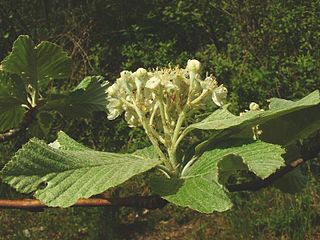
The whitebeams are members of the family Rosaceae, comprising the genus Aria. They are deciduous trees with simple or lobed leaves, arranged alternately. They are related to the rowans, and many of the endemic restricted-range apomictic microspecies of whitebeam in Europe are thought to derive from hybrids between the common whitebeam and the European rowan. Some are also thought to be hybrids with the wild service tree, and the service tree of Fontainebleau found in French woodlands.
The Arran whitebeams are species of whitebeam endemic to the island of Arran, Ayrshire, Scotland.
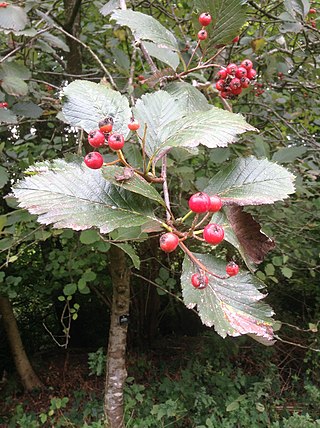
Hedlundia anglica, the English whitebeam, is a species of whitebeam tree in the family Rosaceae. It is uncommonly found in Ireland and the United Kingdom, with an entire British population estimated at about 600 individuals.

Aria eminens, commonly known as the round-leaved whitebeam, is a species of plant in the family Rosaceae. It is endemic to Great Britain and is threatened by habitat loss.
Aria lancastriensis, commonly known as the Lancashire whitebeam, is a species of deciduous tree or shrub in the family Rosaceae, growing to 6 m (20 ft). It is endemic to England, and is found within a 30 km (19 mi) radius from Morecambe Bay, in Lancashire. It is threatened by habitat loss. It has oval leaves. White blossom in spring is followed by orange to red berries in autumn.
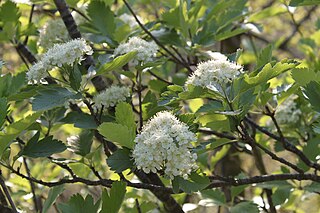
Sorbus leyana. Ley's whitebeam is a species of small tree which is endemic to two sites in southern Wales. It is thought to have arisen by hybridisation of two species of Sorbus, one of which was the rowan. Its closest relatives are some of the other hybrid derived Sorbus species found in Britain.
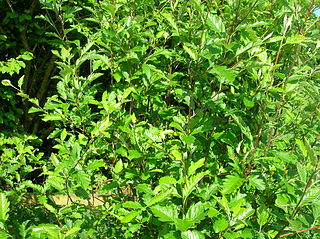
Hedlundia pseudofennica, also called Arran service-tree or Arran cut-leaved whitebeam, is a species of plant in the family Rosaceae. Endemic to the Isle of Arran in Scotland, it is threatened by habitat loss. It is thought to be a naturally occurring hybrid between H. arranensis and Sorbus aucuparia, probably with additional backcrossing with S. aucuparia. Hedlundia arranensis is itself a hybrid between Aria rupicola and S. aucuparia. Apomixis and hybridization are common in some groups of Sorbus species.
Karpatiosorbus subcuneata, the Somerset whitebeam, is a species of plant in the family Rosaceae. It is endemic to coastal north Devon and west Somerset in the United Kingdom. It is threatened by habitat loss.
Aria vexans, commonly known as bloody whitebeam, is a rare species of tree in the family Rosaceae. It is endemic to England and is found along the coast between Culbone in Somerset and an area just west of Trentishoe in Devon. It can be seen in the Exmoor National Park. It is threatened by habitat loss.
Aria wilmottiana, commonly known as Willmott's whitebeam, is a species of whitebeam in the family Rosaceae. It is endemic to England, and is found in the Avon Gorge, in Somerset and Gloucestershire. It is threatened by habitat loss.
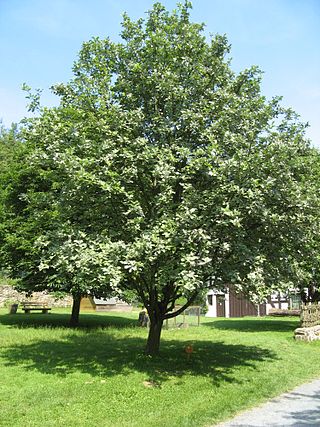
Aria edulis, the whitebeam or common whitebeam, is a species of deciduous tree in the family Rosaceae. It is native to most of Europe as well as North Africa and temperate Asia. Typically compact and domed, with few upswept branches and almost-white underside of the leaves, it generally favours dry limestone and chalk soils. The hermaphrodite cream-white flowers appear in May, are insect pollinated, and go on to produce scarlet berries, which are often eaten by birds.
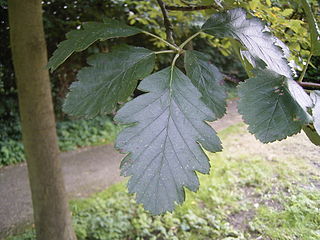
Scandosorbus intermedia or, formerly, Sorbus intermedia, the Swedish whitebeam, is a species of whitebeam found in southern Sweden, with scattered occurrences in Estonia, Latvia, easternmost Denmark (Bornholm), the far southwest of Finland, and northern Poland.

Hedlundia hybrida, the oakleaf mountain ash, Swedish service-tree or Finnish whitebeam, is a species of whitebeam native to Norway, eastern Sweden, south-western Finland, and locally in Latvia.

Sorbus minima, commonly known as the lesser whitebeam or least whitebeam, is a shrub belonging to the subgenus Aria (whitebeams) in the genus Sorbus. It is endemic to Wales where it grows at a few sites in Breconshire. It is an apomictic microspecies which reproduces asexually and so is reproductively isolated from its close relatives such as the Swedish whitebeam, S. intermedia. It probably originated as a hybrid between the rock whitebeam and the rowan. It was first discovered in 1893 by Augustin Ley, the vicar of Sellack in Herefordshire who travelled widely in Wales.

Karpatiosorbus admonitor, previously classified as Sorbus admonitor and also called the no parking whitebeam, is a species of whitebeam tree found in Devon, United Kingdom. It is known only from the Watersmeet Valley at Lynton, with two stray plants growing on the coast above Sillery Sands, Countisbury.
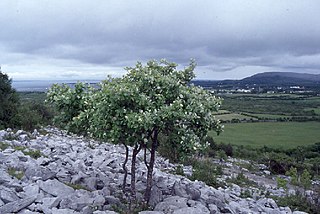
Aria hibernica, commonly known as Irish whitebeam, is a species of whitebeam endemic to Ireland. It occurs in most counties, usually as scattered individuals, or in small groups.
Hedlundia scannelliana, commonly known as Scannell's whitebeam, is a species of shrub or tree endemic to Ross Island near Killarney in southwest Ireland. It is one of the rarest tree species in the world; only five individual plants are known.
Aria leighensis, commonly known as Leigh Woods whitebeam, is a rare species of whitebeam, a flowering plant in the|rose family Rosaceae.
Sorbus arvonensis, called the Menai Strait whitebeam or Cerddin Menai, is a whitebeam species in the rose family. It is native to a restricted area along the shore of the Menai Strait in North Wales. The species was first described by Sell (2014) and has been assessed as Critically Endangered.












